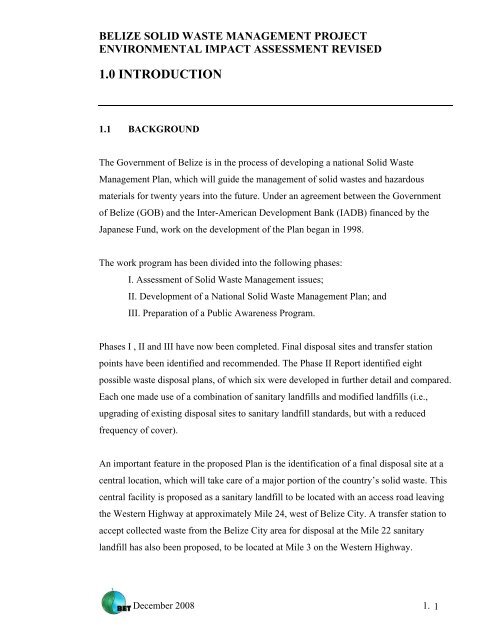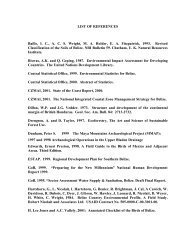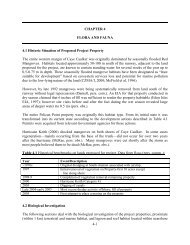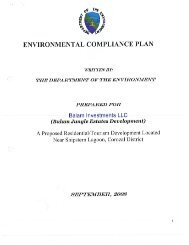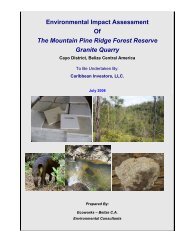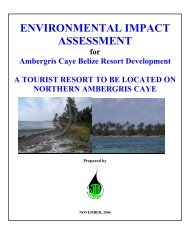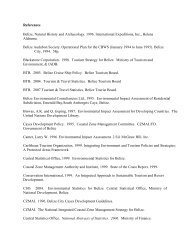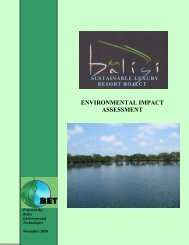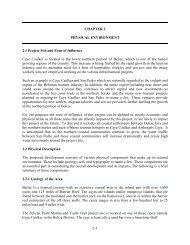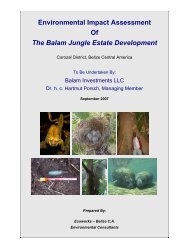belize solid waste management project - Department of Environment
belize solid waste management project - Department of Environment
belize solid waste management project - Department of Environment
You also want an ePaper? Increase the reach of your titles
YUMPU automatically turns print PDFs into web optimized ePapers that Google loves.
BELIZE SOLID WASTE MANAGEMENT PROJECT<br />
ENVIRONMENTAL IMPACT ASSESSMENT REVISED<br />
1.0 INTRODUCTION<br />
1.1 BACKGROUND<br />
The Government <strong>of</strong> Belize is in the process <strong>of</strong> developing a national Solid Waste<br />
Management Plan, which will guide the <strong>management</strong> <strong>of</strong> <strong>solid</strong> <strong>waste</strong>s and hazardous<br />
materials for twenty years into the future. Under an agreement between the Government<br />
<strong>of</strong> Belize (GOB) and the Inter-American Development Bank (IADB) financed by the<br />
Japanese Fund, work on the development <strong>of</strong> the Plan began in 1998.<br />
The work program has been divided into the following phases:<br />
I. Assessment <strong>of</strong> Solid Waste Management issues;<br />
II. Development <strong>of</strong> a National Solid Waste Management Plan; and<br />
III. Preparation <strong>of</strong> a Public Awareness Program.<br />
Phases I , II and III have now been completed. Final disposal sites and transfer station<br />
points have been identified and recommended. The Phase II Report identified eight<br />
possible <strong>waste</strong> disposal plans, <strong>of</strong> which six were developed in further detail and compared.<br />
Each one made use <strong>of</strong> a combination <strong>of</strong> sanitary landfills and modified landfills (i.e.,<br />
upgrading <strong>of</strong> existing disposal sites to sanitary landfill standards, but with a reduced<br />
frequency <strong>of</strong> cover).<br />
An important feature in the proposed Plan is the identification <strong>of</strong> a final disposal site at a<br />
central location, which will take care <strong>of</strong> a major portion <strong>of</strong> the country’s <strong>solid</strong> <strong>waste</strong>. This<br />
central facility is proposed as a sanitary landfill to be located with an access road leaving<br />
the Western Highway at approximately Mile 24, west <strong>of</strong> Belize City. A transfer station to<br />
accept collected <strong>waste</strong> from the Belize City area for disposal at the Mile 22 sanitary<br />
landfill has also been proposed, to be located at Mile 3 on the Western Highway.<br />
December 2008 1.<br />
1
BELIZE SOLID WASTE MANAGEMENT PROJECT<br />
ENVIRONMENTAL IMPACT ASSESSMENT REVISED<br />
A transfer station is also proposed for the Western Sanitary Landfill to serve the<br />
Benque, San Ignacio areas with <strong>waste</strong>s being taken to the Mile 22 site for disposal. In<br />
addition transfer stations have been proposed for the Cayes (Ambergris and Caulker)<br />
where <strong>waste</strong>s would be placed in specialized containers then barged and trucked for<br />
disposal at the central landfill site.<br />
In addition, the recommended plan includes five modified disposal facilities (at<br />
Corozal, Orange Walk, and new sites at Dangriga, Placencia and Punta Gorda).<br />
In preparation for the detailed design <strong>of</strong> the Central Sanitary Landfill Site, the GOB<br />
requires that an <strong>Environment</strong>al Impact Assessment (EIA) be conducted to assess the<br />
potential environmental and related impacts <strong>of</strong> the proposed facility.<br />
In preparation for the detailed design <strong>of</strong> the regional landfill, the GOB requires that an<br />
<strong>Environment</strong>al Impact Assessment (EIA) be conducted to assess the potential<br />
environmental and related impacts <strong>of</strong> the proposed facility. This Report presents the<br />
results <strong>of</strong> an EIA for the Mile 22 Site, including siting criteria and rapid assessments <strong>of</strong><br />
alternative sites investigated leading to the selection <strong>of</strong> the site. It also includes the results<br />
<strong>of</strong> an updated review and assessment <strong>of</strong> the plan and previously approved EIA report<br />
prepared by Stantec Consulting International Ltd in 2001. While the report<br />
focuses on an EIA prepared for the proposed regional <strong>waste</strong> <strong>management</strong> site located at<br />
the Mile 22 Site, it also provides information relevant to the municipal <strong>waste</strong> <strong>management</strong><br />
sites (Recycling / Transfer Stations) located in San Pedro, Caye Caulker and Belize City.<br />
1.2 OBJECTIVES<br />
The objectives <strong>of</strong> the <strong>Environment</strong>al Impact Assessment are:<br />
to review the siting efforts undertaken for the central site leading to the<br />
recommendation <strong>of</strong> the Mile 22 site as the prime Central Landfill candidate<br />
sites;<br />
December 2008 1.<br />
2
BELIZE SOLID WASTE MANAGEMENT PROJECT<br />
ENVIRONMENTAL IMPACT ASSESSMENT REVISED<br />
to identify and assess the significance <strong>of</strong> potential impacts (positive and<br />
adverse) to living and non-living components <strong>of</strong> the environment resulting<br />
from the proposed activities, and socio-economic impacts stemming from<br />
environmental threats; and<br />
to recommend measures for eliminating or reducing the risk and magnitude<br />
<strong>of</strong> adverse environmental effects (mitigation), and for detecting adverse<br />
effects in time to correct them (monitoring).<br />
1.3 EIA REQUIREMENTS<br />
The Belize <strong>Environment</strong>al Protection Act Revised Edition 2003 requires an<br />
<strong>Environment</strong>al Impact Assessment (EIA) to be undertaken for any “<strong>project</strong>, program or<br />
activity that may significantly affect the environment”. The EIA is normally prepared by<br />
the proponent and submitted for review by the National <strong>Environment</strong>al Appraisal<br />
Committee (NEAC), whose function it is to ensure that the proposed undertaking takes<br />
into account all <strong>of</strong> the requirements, policies and regulations for protection <strong>of</strong> the<br />
environment, natural resources and socio-economic conditions, and is consistent with<br />
other land use in the area. Following review by NEAC, if the <strong>project</strong> is allowed to<br />
proceed, a Compliance Plan for the development and operation <strong>of</strong> the proposed works or<br />
activities is agreed between the proponent and DOE.<br />
The GOB has determined that the proposed sanitary landfill at Mile 22 <strong>of</strong> the Western<br />
Highway is subject to the requirement for an EIA, and in fact the EIA Regulations list a<br />
<strong>waste</strong> disposal installation as requiring an EIA. Among other things, the <strong>Department</strong> <strong>of</strong><br />
<strong>Environment</strong>’s procedures for the preparation <strong>of</strong> an EIA include the following elements:<br />
policy and legal basis within which the <strong>project</strong> may be implemented;<br />
description <strong>of</strong> the proposed <strong>project</strong>;<br />
description <strong>of</strong> the environment;<br />
identification <strong>of</strong> significant environmental impacts;<br />
analysis <strong>of</strong> alternatives;<br />
December 2008 1.<br />
3
BELIZE SOLID WASTE MANAGEMENT PROJECT<br />
ENVIRONMENTAL IMPACT ASSESSMENT REVISED<br />
mitigation plan; and<br />
monitoring plan.<br />
The Terms <strong>of</strong> Reference for the <strong>Environment</strong>al Impact Assessment are shown in<br />
Appendix A. These elements are addressed in various sections <strong>of</strong> this Report.<br />
Appendix B contains a list <strong>of</strong> contributors to the preparation <strong>of</strong> this EIA, as well as a list<br />
<strong>of</strong> reference. A siting matrix was developed, which compares criteria used to<br />
compare proposed Landfill sites is contained in Appendix C. Appendix D contains<br />
the meeting minutes <strong>of</strong> a Stakeholder’s Meeting (held on June 1, 2001) conducted during<br />
the preparation <strong>of</strong> this EIA. Appendix E presents site photos. Appendix F is the<br />
Hydrogeological Report on the site, with Appendix G being the recommended monitoring<br />
program. Appendix H is an excerpt from the pre-design proposal for the construction and<br />
operation <strong>of</strong> transfer stations. Appendix I contains an Archaeological Report submitted by<br />
the Institute <strong>of</strong> Archaeology. Appendix J containes ETEISA Lab Reports <strong>of</strong> Leachate<br />
Analyses for San Pedro, Caye Caulker and Belize City disposal site. Appendix K and L<br />
include information on <strong>waste</strong> characterization conducted for San Pedro, Caye Caulker and<br />
Belize City by ETEISA and F. Panton respectively. Appendix M contains new geotechnical<br />
analyses conducted by Shanon and wilson.<br />
1.4 SCOPE<br />
This EIA presents the investigations undertaken in reviewing a large number <strong>of</strong><br />
potential sites and the rationale for selecting the Mile 22 Site. The EIA addresses potential<br />
impacts (positive and negative) on air quality, terrain, surface and round water quality,<br />
and terrestrial ecosystems. The EIA also addresses socio-economic impacts directly<br />
related to environmental impacts, such as odor, smoke, litter, pests, noise, aesthetics, and<br />
land-use issues. The geographical scope <strong>of</strong> the Assessment includes the site <strong>of</strong> disposal<br />
and related activities <strong>of</strong> the Mile 22 Sanitary Landfill, and an area <strong>of</strong> approximately 4 Km<br />
radius around the disposal site, but also taking into consideration the total air shed, water<br />
movements and visual area <strong>of</strong> influence <strong>of</strong> the site. Figure 1.1 shows the proposed<br />
December 2008 1.<br />
4
BELIZE SOLID WASTE MANAGEMENT PROJECT<br />
ENVIRONMENTAL IMPACT ASSESSMENT REVISED<br />
location <strong>of</strong> the Mile 22 Western Highway regional sanitary landfill facility and the study<br />
area.<br />
In terms <strong>of</strong> the <strong>project</strong> components to be assessed, the EIA addresses potential impacts<br />
related to the new sanitary landfill facility and the site access road at the<br />
Mile 22 Western Highway site and related operations including the proposed Solid<br />
Waste Transfer Sites at Mile 3 <strong>of</strong> the Western Highway Western Sanitary Landfill and the<br />
Cayes. It considers construction, operational and post-operational phases <strong>of</strong> the <strong>project</strong>.<br />
The proposed new sanitary landfill facility is described in Section 3.0.<br />
December 2008 1.<br />
5
BELIZE SOLID WASTE MANAGEMENT PROJECT<br />
ENVIRONMENTAL IMPACT ASSESSMENT REVISED<br />
December 2008 1. 6


